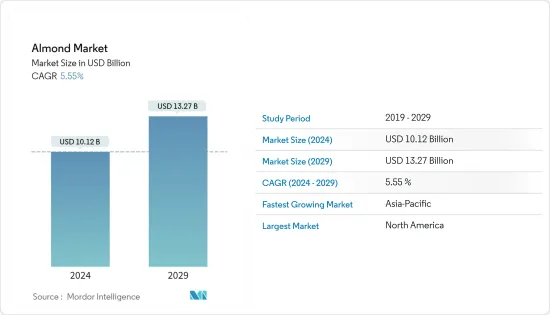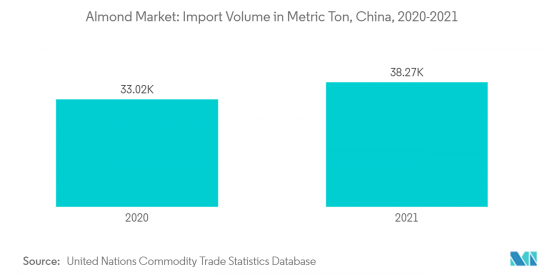 |
市場調査レポート
商品コード
1406176
アーモンド:市場シェア分析、産業動向・統計、成長予測、2024年~2029年Almond - Market Share Analysis, Industry Trends & Statistics, Growth Forecasts 2024 - 2029 |
||||||
● お客様のご希望に応じて、既存データの加工や未掲載情報(例:国別セグメント)の追加などの対応が可能です。 詳細はお問い合わせください。
| アーモンド:市場シェア分析、産業動向・統計、成長予測、2024年~2029年 |
|
出版日: 2024年01月04日
発行: Mordor Intelligence
ページ情報: 英文 130 Pages
納期: 2~3営業日
|
- 全表示
- 概要
- 目次
アーモンド市場規模は2024年に101億2,000万米ドルと推定され、2029年には132億7,000万米ドルに達すると予測され、予測期間中(2024-2029年)のCAGRは5.55%で成長すると予測されます。

主なハイライト
- アーモンドは、透明性、植物を前面に押し出した革新性、ホリスティックで個別化された栄養、おいしい感覚体験を求める消費者ニーズの高まりに合致しており、飲食品の動向が進化する中で、消費者に否定できない魅力を持ち続けています。ミネラルと栄養素を多く含むアーモンドは、さまざまなタイプの食品用途に加えられる、より汎用性の高い健康的な素材であり、消費者に豊かな栄養価を提供しています。しかし、アーモンドは高価な商品であるため生産コストが高く、様々な発展途上国における経済不安の中、消費の妨げとなっています。
- さらに、国連食糧農業機関(FAO)によると、アーモンドの主要生産国は米国であり、スペイン、イラン、オーストラリアがこれに続く。肥沃な土壌と豊富な日照を持つ良好な気候と、北米の成長、収穫、加工、包装の際に使用される必要な機器は、アーモンドの生産強化に有利です。このように、健康上の利点と健康意識の高まりに起因する需要の増加に伴い、市場は予測期間中に成長すると予想されます。
アーモンド市場の動向
ヘルシースナック志向の高まり
一般的なナッツの摂取量を調査した医療専門家による1次疫学調査によると、木の実、特にアーモンドを週に2回以上摂取すると、総心血管系疾患のリスクが13%低下し、冠動脈性心疾患のリスクが15%低下すると報告されています。健康的で栄養価の高いスナック食品への嗜好は、輸入と最終的な消費の増加から明らかなように、中国や米国などの新興国市場で安定した成長を維持するのに役立つと予想されます。消費者のライフスタイルの変化、急速な都市化、および高い可処分所得は、外出先でのヘルシーなコンビニエンスフードの需要を高め、調理済み食品市場の成長に拍車をかけています。急速な都市化と可処分所得の増加は、食品消費習慣の変化を促し、そうした食品への支出意欲を高める。こうした要因は、最終消費者の食品支出をさらに押し上げます。
さらに、メーカー各社はアーモンドを丸ごと、または原材料として使用した革新的で健康志向の製品を発売しており、世界のヘルシースナックセグメントにおけるビジネスを拡大しています。こうした製品は、菜食主義者や健康志向の高い消費者の間で人気を集めています。例えば、ペプシコは2021年3月、脱脂アーモンド粉をベース原材料とする低炭水化物スナック・ブランド「Hilo Life」を北米で発売しました。同社によると、この新製品は従来のアーモンド粉よりも脂肪分が少なく、タンパク質が多いです。

北米が生産量で市場をリード
生産量、消費量、輸出量が多いため、北米は世界のアーモンド市場で最大のシェアを占めています。米国はアーモンド市場で最大のシェアを獲得し続けています。米国農務省の報告によると、2020年のアーモンド生産量は414万0,043.0トンで前年比35.1%増となります。しかし、2021~2022年の1本当たりの平均着果数は12%減少し、着果面積の4%増を補って余りある結果となり、米国の生産量は11%減の120万トンとなる見込みです。良好な受粉条件で収穫が始まったにもかかわらず、気温が高かったため、開花時期が例年より短かった。さらに、2月の最終週に凍結に見舞われた地域もあり、ナッツの着果が不十分で収穫できなかったエーカーもあったため、生産量が減少したという主張もあります。
また、国連商品貿易統計データベースによると、2021年にはスペイン、ドイツ、オランダ、日本、アラブ首長国連邦が米国からアーモンドの半分以上を輸入します。アーモンドのほとんどは米国で栽培されているが、オーストラリア、スペイン、ベトナムも米国市場の需要増に対応するため、アーモンドを米国市場に送っています。その健康上の利点から、アーモンドを使ったスナックはこの地域でますます人気が高まっています。栄養価の高い食品に対する需要の高まりと、肥満率の高い人口の増加が懸念されていることが、過去数年間の市場成長の主な理由です。肥沃な土壌と豊富な日照に恵まれた北米の気候と、生育、収穫、加工、包装に必要な設備は、アーモンドの生産強化に有利です。
その他の特典:
- エクセル形式の市場予測(ME)シート
- 3ヶ月間のアナリスト・サポート
目次
第1章 イントロダクション
- 調査の前提条件と市場定義
- 調査範囲
第2章 調査手法
第3章 エグゼクティブサマリー
第4章 市場力学
- 市場概要
- 市場促進要因
- 市場抑制要因
- サプライチェーン/バリューチェーン分析
第5章 市場セグメンテーション生産分析(数量)、消費分析(金額と数量)、輸出分析(金額と数量)、輸入分析(金額と数量)、価格動向分析
- 地域
- 北米
- 米国
- 欧州
- スペイン
- イタリア
- ポルトガル
- ギリシャ
- アジア太平洋
- イラン
- トルコ
- オーストラリア
- 中国
- インド
- ベトナム
- 南米
- チリ
- アルゼンチン
- 中東・アフリカ
- モロッコ
- チュニジア
- サウジアラビア
- エジプト
- 北米
第6章 市場機会と今後の動向

The Almond Market size is estimated at USD 10.12 billion in 2024, and is expected to reach USD 13.27 billion by 2029, growing at a CAGR of 5.55% during the forecast period (2024-2029).
Key Highlights
- Aligning with an escalating consumer need for transparency, plant-forward innovation, holistic and individualized nutrition, and delicious sensory experiences, almonds continue to have undeniable consumer appeal as food and beverage trends evolve. The high presence of minerals and nutrients makes almonds a more versatile and healthy ingredient added to different types of food applications, providing rich nutritional value to consumers. However, the high cost of production, resulting in the commodity's expensive nature, has hindered consumption during the economic uncertainty in different developing countries.
- Further, according to the Food and Agriculture Organization (FAO), the United States is the primary producer of almonds, followed by Spain, Iran, and Australia. The favorable climate with fertile soil and abundant sunshine and the required equipment to be used during growth, harvesting, processing, and packaging in North America favor the enhanced production of almonds. Thus, with increasing demand owing to the health benefits and increased health awareness, the market is anticipated to grow during the forecast period.
Almond Market Trends
Growing Inclination Towards Healthy Snacking
Tree nuts, especially almonds, consumed two or more times per week were linked to a 13% lower risk of total cardiovascular disease and a 15% lower risk of coronary heart disease, according to primary epidemiological research by health professionals who examined general nut intake. The preference for healthy and nutritious snack foods is expected to help maintain steady growth in developed markets such as China and the United States, as evident from the increased imports and eventual consumption. The changing consumer lifestyle, rapid urbanization, and high disposable income increase the demand for on-the-go healthy convenience foods, fueling the ready-to-eat food market's growth. Rapid urbanization and rising disposable income encourage changes in food consumption habits and a greater willingness to spend on such foods.These factors further boost the food expenditure of the final consumer.
Moreover, manufacturers are launching innovative and health-oriented products consisting of almonds, either as a whole or as an ingredient, thus expanding their business in the global healthy snack segment. These products are gaining popularity among vegans and highly health-conscious consumers. For instance, in March 2021, PepsiCo introduced Hilo Life, a low-carb snack brand in North America, using defatted almond flour as a base ingredient. According to the company, this new product has less fat and more protein than traditional almond flour.

North America is Leading the Market in Terms of Production
Due to more production, consumption, and exports, North America has the largest share of the world's almond market.The United States continues to capture the largest market share for almonds. According to the Food and Agricultural Organization, almond production in 2020 will account for 4,140,043.0 metric tons, a 35.1% increase over previous years.However, the average number of nuts set per tree has declined by 12 percent in 2021-2022, more than compensating for an increase in bearing acres of 4 percent and resulting in an anticipated 11 percent decline in U.S. production to 1.2 million tons, according to the United States Department of Agriculture report. Even though the harvest began with good pollination conditions, warm temperatures led to a shorter bloom time than in previous years. Additionally, there are claims that some areas experienced a freeze in the final week of February, which left some acres unharvested due to an inadequate nut set, resulting in a decline in production.
Also, the United Nations Commodity Trade Statistics Database says that Spain, Germany, the Netherlands, Japan, and the United Arab Emirates will import more than half of the almonds from the United States in 2021. Almonds are mostly grown in the United States, but Australia, Spain, and Vietnam also send almonds to the US market to meet the growing demand there. Due to their health benefits, almond-based snacks are becoming more and more popular in the area. The rising demand for highly nutritious foods and the concerns of a significant population with a high rate of obesity have been some of the main reasons behind the market's growth over the past few years. The favorable climate in North America with fertile soil and abundant sunshine and the required equipment to be used during growth, harvesting, processing, and packaging favor the enhanced production of almonds.
Additional Benefits:
- The market estimate (ME) sheet in Excel format
- 3 months of analyst support
TABLE OF CONTENTS
1 INTRODUCTION
- 1.1 Study Assumptions and Market Definition
- 1.2 Scope of the Study
2 RESEARCH METHODOLOGY
3 EXECUTIVE SUMMARY
4 MARKET DYNAMICS
- 4.1 Market Overview
- 4.2 Market Drivers
- 4.3 Market Restraints
- 4.4 Supply Chain/Value Chain Analysis
5 MARKET SEGMENTATION Production Analysis (Volume), Consumption Analysis (Value and Volume), Export Analysis (Value and Volume), Import Analysis (Value and Volume), and Price Trend Analysis.
- 5.1 Geography
- 5.1.1 North America
- 5.1.1.1 United States
- 5.1.2 Europe
- 5.1.2.1 Spain
- 5.1.2.2 Italy
- 5.1.2.3 Portugal
- 5.1.2.4 Greece
- 5.1.3 Asia-Pacific
- 5.1.3.1 Iran
- 5.1.3.2 Turkey
- 5.1.3.3 Australia
- 5.1.3.4 China
- 5.1.3.5 India
- 5.1.3.6 Vietnam
- 5.1.4 South America
- 5.1.4.1 Chile
- 5.1.4.2 Argentina
- 5.1.5 Middle-East and Africa
- 5.1.5.1 Morocco
- 5.1.5.2 Tunisia
- 5.1.5.3 Saudi Arabia
- 5.1.5.4 Egypt
- 5.1.1 North America
